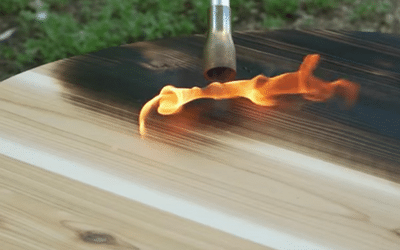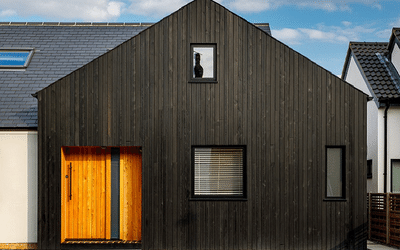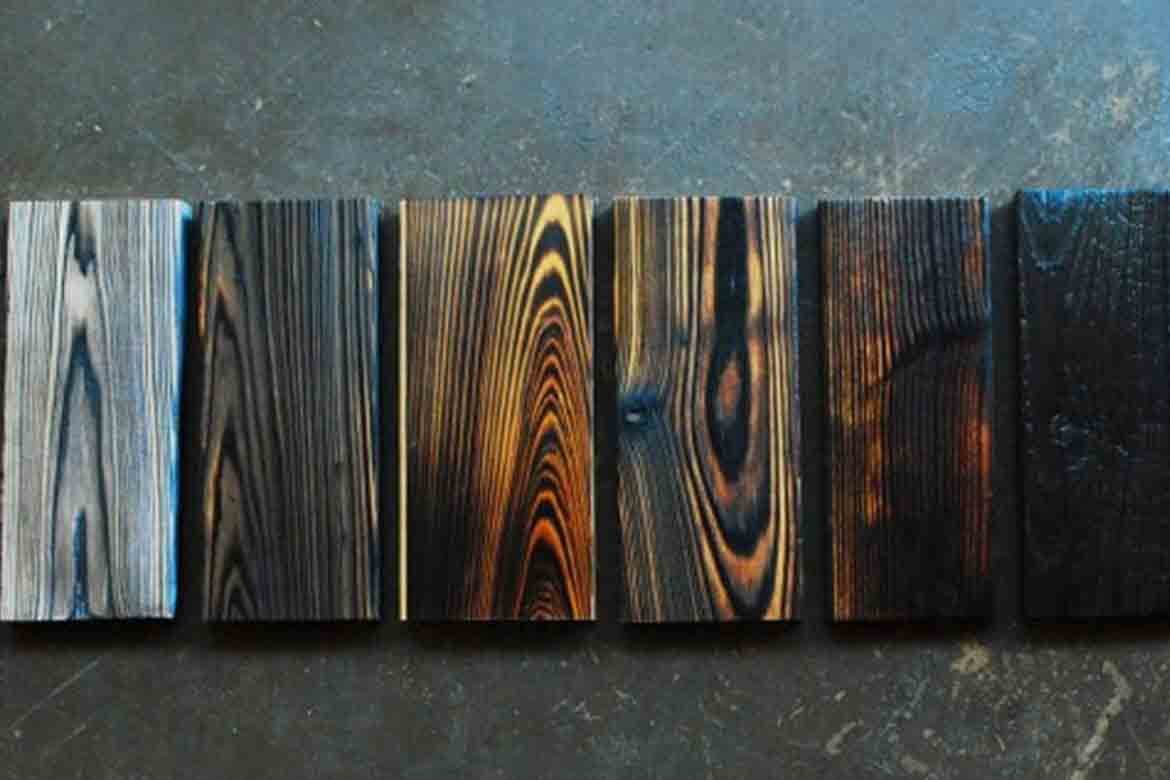Shou Sugi Ban’s rise in popularity isn’t surprising. The time-proven wood preservation technique leaves your wood projects stronger and more gorgeous. In addition, it increases pest and rot resistance.
Unfortunately, not all types of wood are ideal for wood burning. So, you may have to go shopping if you’ve decided to burn the boards for your next woodworking project.
Below are the nine best kinds of wood for Shou Sugi Ban projects.
Best Wood for Shou Sugi Ban
Japanese red Cedar is the best wood for the Shou Sugi Ban process because of its natural chemical composition. Moreover, cedar is light and porous, enabling easy and fast burning. Above all, cedar easily withstands momentary subjection to high temperatures and looks stunning when burned. Besides cedar planks, consider Accoya, pine, and Siberian larch.
What’s the Shou Sugi Ban or Yakisugi
Shou Sugi Ban is a traditional Japanese technique for preserving wood. It was originally known as “Yakisugi” in Japan, though most Westerners call it Shou Sugi Ban.
“Yaki means “to heat with fire,” while sugi is the Japanese word for the Japanese cedar (cryptomeria japonica). Meanwhile, “ban” is the Japanese term for “wood plank.”
First used in the 18th century, Shou Sugi Ban increases a wood plank’s natural resistance to weather and other external elements.
It also enhances the wood’s aesthetics and creates a pleasing alligator skin that looks stunning in contemporary exteriors.
The wood charring process begins with wood selection. Then the selected boards are dried and cleaned. After that, the planks are lightly burned using a propane torch.
This is the most technical part, as too little or too much burning can compromise the results. When done, the next step is to wire-brush the burnt wood to remove the outermost burned layer. Wire brushing also reveals the hidden grain texture.
You can also use coarse sandpaper. After wire brushing, use an air compressor to blow away the excess dust and wipe the surface with a wet cloth. Then coat the wooden plank with a wood finish like tung oil.
How to Shou Sugi Ban
Here is a step-by-step guide on how to achieve the Shou Sugi Ban look:
Equipment Needed:
- Wood (cedar, cypress, or pine)
- Heat source (propane torch, weed burner, or blowtorch)
- Wire brush
- Coarse sandpaper
- Finishing oil (tung oil or linseed oil)
- Brush for oil application
- Safety equipment (respirator, safety goggles, protective clothing)
Steps:
- Burn the wood: Use a heat source to burn the wood until it is charred black. The intensity of the charring can be varied depending on the desired finish. Ensure that the entire surface of the wood is charred evenly.
- Allow the wood to cool: Once the wood is charred, let it cool to room temperature before handling it.
- Clean the wood surface: Use a wire brush to remove any loose or excess soot from the wood surface. Be careful not to remove too much of the charred finish.
- Sand the wood: Use coarse sandpaper to smooth any rough areas on the wood surface. This step will also help to remove any remaining loose soot.
- Apply finishing oil: Apply a finishing oil, such as tung oil or linseed oil, to the wood surface using a brush. The oil will help to protect the wood and bring out the color and texture of the charred finish.
- Let the oil dry: Allow the oil to dry completely according to the manufacturer’s instructions.
- Optional: Apply a second coat of oil for added protection and to enhance the finish.
Follow these steps and use the proper equipment and safety precautions, to achieve the unique and beautiful Shou Sugi Ban finish on your wood surfaces.

Charred Wood Benefits
The charring process has several valuable benefits to wood preservation and beautification. Some of the practical benefits include the following;
- Increased pest resistance
- Increased insect resistance
- Enhanced rot resistance
- Low maintenance
- Durability (burned wood can last 80+ years)
- It enhances the wood’s natural aesthetics
- increased decay resistance
Pros and Cons of Shou Sugi Ban Technique
Pros
- Aesthetic appeal
- Durability
- Sustainability
- Versatility
Cons
- Cost
- Health concerns
- Limited color options
- Rough texture
Factors to Consider When Choosing Wood for the Shou Sugi Ban Process
Unfortunately, Shou Sugi Ban doesn’t work equally on all types of wood. The following are four critical characteristics of the best woods for the traditional Japanese technique;
High porosity
Shou Sugi Ban works best on highly porous wood because the molecular structure of these woods allows for easy char accumulation on the surface. Additionally, porous woods allow deep heat penetration and dry fast for the best results.
Lightweight
Low-density, lightweight woods produce the best Shou Sugi Ban results. Again, deep heat penetration and fast dry times are the main benefits. In addition, lightweight woods are easier to handle.
Beautiful grain pattern
Grain structure is not a deal breaker when selecting wood for the Shou Sugi Ban process. Nevertheless, wood types with beautiful grain patterns and distinct lines produce excellent surface patterns.
Natural chemical properties
High charring depth is critical to long-term wood preservation. Therefore, the best woods for Shou Sugi Ban possess chemical properties that enable deep burning. But, more importantly, you don’t want wood that produces toxic fumes during charring.

9 Best Shou Sugi Ban Wood Types
Here are a few excellent wood species that I identified for this process. They include;
1. Japanese Shou sugi ban cedar
Japanese red cedar is the best Shou Sugi Ban wood. Also known as Japanese rosewood or peacock pine, it’s a coniferous evergreen timber tree native to eastern Asia. It grows to 70m, with trunk diameters up to 4.0 meters.
Cryptomeria Japonica timber is lightweight, waterproof, and decay-resistant. The fragrant reddish brown wood also boasts beautiful wood grains and is highly durable.
2. Western red cedar
The western red cedar is a species native to the Pacific coast and North America. Also known as the western arborvitae, giant abortive, or Pacific red cedar, it’s the next best option for Shou Sugi Ban after the Japanese cedar. As such, many people call it the Shou sugi ban cedar.
This wood-burning wood type is highly resistant to weather and other external factors. It’s also insect and pest resistant and provides an attractive finish when charred. This quality makes it one of the best wood for pergolas.
3. Accoya wood
Accoya refers to pine wood that has undergone acetylation, which involves permanently modifying the wood’s structure, with acetic anhydride as the main reagent.
As a result, Accoya wood boasts increased durability, rot, and UV resistance, and paint retention. It lasts 50+ years without charring and a lifetime after burning.
The only downside is accessibility. Unfortunately, Accoya, a relatively new product, is not easy to find and, therefore, often expensive.
4. Shou sugi ban pine
Charred pinewood is one of the best choices for siding and cladding projects. A few people also used it for fencing projects with exceptional results.
Its main advantage is versatility. Pinewood is a versatile softwood applicable to many projects. It’s also durable and rot-resistant.
Shou sugi ban pine is durable and resistant to external elements like weather, pests, and insects. It’s also strikingly beautiful.
5. Shou sugi ban Maple
Although softwoods are the best choice for Shou Sugi Ban processes, a few hardwoods make the grade. One example is maple. It boasts fine grains that look even subtler when charred, creating a stunning, uniform texture.
Shou Sugi Ban maple is durable and highly appealing. However, the specific qualities depend on maple species. Moreover, you must take precautions to prevent splitting and warping. Nevertheless, charred maple makes great sense for many indoor projects.
6. Hemlock
Another hardwood to consider for Shou Sugi Ban is hemlock. It’s a low-density wood (500kg/m3) readily available at most timber merchants. Moreover, hemlock is highly affordable.
Unfortunately, hemlock is difficult to treat with traditional wood treatment methods. So, burning is a great alternative.
It burns to a finely textured surface with enhanced weather and pest-resistance properties. Charred hemlock is also impressively water resistant.
7. Siberian larch
The Siberian Larch is a hardy tree native to Finland and Russia. It’s popular in Europe and other cold climates because it readily withstands the harsh winters. Moreover, the Siberian larch doesn’t shrink or warp with changing temperatures.
Many homeowners use charred Siberian Larch boards on residential sidings, where the wood’s deep texture stands out. Unfortunately, it isn’t easy to find in other parts of the world.
8. Shou sugi ban oak
Oak is one of the most popular hardwoods in the furniture and flooring industries. In addition, its natural strength, hardness, and resistance to various conditions make it attractive for construction projects like paneling and decking.
Above all, oakwood boasts close grains and high tannin content. These qualities make Shou Sugi Ban oak a wonderful choice for construction projects. However, oak splits readily. So, take precautions to prevent overexposure.
9. Spruce wood
Spruce is a popular softwood easily recognizable by its strong resinous smell. The uniformly bright wood is almost white and has highly desirable elasticity and strength properties. It’s also a low-density wood, weighing about 450kg/m3.
The main advantage of burning spruce wood is that it’s lightweight and thus dries fast. Additionally, the low density allows deep heating penetration for a durable burnt appearance. Of course, spruce is also readily available and very affordable.
Read also: White vs red cedar
Finishing Shou Sugi Ban Wood
Finishing Shou Sugi Ban wood starts immediately after the wood cools down. First, use a wire brush to remove the top layer of the char, working in the grain direction. Alternatively, use coarse sandpaper if you wish only to remove a tiny layer.
Then remove the surface dust using an air compressor or wiping it with a wet cloth. Allow the surface to dry completely after wiping before moving to the finishing step.
The best Shou Sugi Ban finish depends on the project type. For instance, is it an interior design job or a plank for exterior applications? Also, what type of wood is it, and why are you finishing it?
Nevertheless, natural wood oils are the best finishes for wood charring projects. These include linseed oil, teak oil, and tung oil finish. Hemp oil is another great choice.
Liberally apply the oil over the wood surface and rub it into the wood using dry, lint-free rags. Then allow the first coat to dry before applying the second coat and allow it to cure overnight.
Read also: What is the best wood for wooden spoons?
Shou Sugi Ban’s Safety Hazards
Shou Sugi Ban can be hazardous to one’s health if proper safety measures are not taken. Here are some safety hazards associated with the use of Shou Sugi Ban:
- Toxic fumes: The charring process creates toxic fumes of carbon monoxide and other harmful gases. These fumes can be hazardous to the health of the worker and anyone nearby if inhaled in large quantities.
- Fire hazard: The embers produced during charring can ignite nearby materials.
- Respiratory hazards: The fine wood dust created during the process can be hazardous if inhaled. It can cause respiratory problems like asthma, bronchitis, or lung cancer.
- Eye and skin irritation: The soot can cause eye and skin irritation.
To minimize these safety hazards, use proper safety equipment. Also, ensure you work in a well-ventilated area and take regular breaks to prevent overexposure to the fumes.
Additionally, have a fire extinguisher nearby and avoid any potential ignition sources.
Woods to Avoid for Yakisugi
While Shou Sugi Ban can be applied to many types of wood, there are certain woods that may not be suitable for this technique due to their properties or characteristics. Here are some woods to avoid for Shou Sugi Ban:
- Softwoods with high resin content: Woods such as spruce, fir, and some pines can have high resin content, which can cause uneven charring and excessive flames during the burning process. These woods may also release toxic fumes when burned.
- Low-density woods: Low-density woods, like balsa or basswood, might not withstand the charring process well and can lose structural integrity more quickly than denser woods.
- Woods treated with chemicals: Avoid using chemically treated woods, such as pressure-treated lumber or wood treated with preservatives, as the chemicals can release harmful fumes during the charring process.
- Woods with high moisture content: Woods with high moisture content can lead to uneven charring and may not achieve the desired results. Always use properly dried and seasoned wood for the Shou Sugi Ban process.
- Woods prone to splitting or warping: Some types of wood, like poplar or willow, are more prone to splitting or warping when exposed to heat. These woods may not be suitable for Shou Sugi Ban.
It is essential to choose the right wood for your Shou Sugi Ban project to achieve the best results and ensure the longevity of the treated wood. As a general rule, stick to recommended wood types like cedar, cypress, larch, redwood, and some varieties of pine, as they have proven to work well with this technique.
Read also: Types of wood used for bows
FAQs
What is the most durable wood for Shou Sugi Ban?
Cedar wood is the most durable wood for Shou Sugi Ban. It’s a naturally resilient wood that becomes even more durable when charred. Indeed, a charred cedar board can last 80+ years, whereas uncharred boards last 15-20 years. Oak and hemlock are other woods that can last many decades when charred.
What is the most affordable wood for Shou Sugi Ban?
Accoya is the most affordable wood for Shou Sugi Ban. It costs between $3.50 and $4.80 per board foot yet produces excellent results when burned. By comparison, cedarwood is more expensive; it costs up to $20 per board foot. Pine wood is an excellent alternative, costing $4 per board foot.
What is the best all-rounder wood for Shou Sugi Ban?
The Japanese red cedar is the best all-rounder wood for the Shou Sugi Ban technique. It’s strong, lightweight, and produces beautiful patterns when burned. The Western red cedar is the next best option if you cannot find the Japanese red cedar. It has the same physical and chemical properties, producing beautiful, highly durable charred boards.
Can you Shou Sugi Ban hardwood?
Yes, you can Shou Sugi Ban hardwood. Indeed, hardwoods like oak and maple are exceptional choices for the Yakisugi technique, producing durable charred boards that can last a lifetime with good maintenance. However, softwoods are better because they burn more easily and enable deeper char penetration. On the other hand, you need immense heat to get good results on hardwoods.
Read also: Best wood for building a sauna
Shou Sugi Ban Wood Types Summary
Shou Sugi Ban is an ancient Japanese technique for preserving wood. Its benefits include enhanced durability, weather resistance, and pest resistance.
Unfortunately, not all woods are good charring candidates. So, you must choose wisely when shopping for boards for your next wood charring project. Japanese red cedar, western red cedar, and Accoya are the best wood for Shou Sugi Ban.

